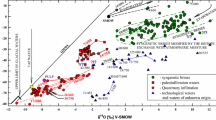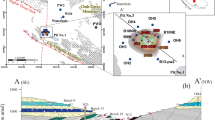Abstract
Several evaporite basins containing bedded salt and dome salt deposits in the USA and Europe are currently being investigated as potential repositories for radioactive waste. While salt has good geomechanical properties for the long-term isolation of radioactive wastes, all such deposits have undergone various degrees of dissolution by circulating unsaturated groundwater. The extent and rate of such dissolution poses a challenge to the geologists evaluating an area for a repository.
Detailed investigations at the Waste Isolation Pilot Plant (WIPP), a proposed repository for transuranic (TRU) radioactive wastes located in the Delaware Basin in Southeastern New Mexico, U.S.A., have outlined a broad dissolution front for the Salado formation. An approximate rate of advance of the dissolution front at 1 km per 100,000 years horizontally and 10 meters per 100,000 years vertically, has been calculated. Similar calculations have been performed for other basins with different degrees of uncertainty due to the limitations in surface mapping and core or well-log correlations. Unless such calculations can be performed satisfactorily, questions will remain about the future integrity of a repository located in such an area.
Résumé
Plusieurs bassins d'évaporites aux États-Unis et en Europe contenant des gisements de sel en couches et en dômes sont actuellement en investigation comme dépôts potentiels des déchets radioactifs. Tandis que le sel a de bonnes propriétés géomécaniques pour l'isolement à long terme des déchets radioactifs, tous ces gisements ont subi plusieurs degrés de dissolution par la circulation d'eau souterraine non saturée. L'étendue et la vitesse de cette dissolution présente un défi aux géologues qui évaluent un site pour un dépôt.
Des recherches détaillées sur l'emplacement du projet WIPP (Waste Isolation Pilot Plant), un des dépôts proposés pour déchets radioactifs transuraniques (TRU) situé dans le bassin Delaware au sud-est de l'état de New Mexico, États-Unis, ont tracé un large front de dissolution pour la formation «Salado». Un taux approximatif d'avance horizontal dufront de dissolution d'un km par 100 000 ans et en sens vertical de 10 mètres par 100 000 ans a été calculé. Des calculs similaires ont été faits pour d'autres bassins, avec différents degrés d'indétermination due aux limitations des levés de plan de la surface et à la corrélation entre sondages rotatifs. A moins que de tels calculs soient faits d'une manière satisfaisante, des questions demeureront sur l'intégrité future d'un dépôt situé dans un tel site.
Similar content being viewed by others
References
ANDERSON R.Y. (1981): Deep-seated salt dissolution in the Delaware Basin. Texas and New Mexico. N.M. Geol. Soc. Spec. Publ. No. 10, p. 133–145.
ANDERSON R.Y. (1982): Deformation-dissolution potential of bedded salt. Waste Isolation Pilot Plant Site, Delaware Basin, New Mexico. Scientific Basis for Nuclear Waste Management. U.S., edited by Werner Lutze. North Holland (Publ.), p. 449–458.
BACHMAN G.O. and JOHNSON R.B. (1973): Stability of salt in the Permian salt basin of Kansas. Oklahoma. Texas and New Mexico. U.S. Geol. Surv. Open File Rept., 4339-4.
BACHMAN G.O. (1980): Geologic processes and cenozoic history of Pecos region, southeastern New Mexico. U.S. Geol. Surv. Open File Rept., 80-1099, 116 p.
CHATURVEDI L. and REHFELDT K. (1984): Groundwater occurrence and the dissolution of salt at the WIPP radioactive waste repository site. Trans. Amer. Geophys. Union (EOS), V. 85. No. 31, p. 457–459.
GOLDMAN M.I. (1933): Origin of the anhydrite caprock of American salt domes. U.S. Geol. Surv. Prof. Paper No. 175.
GUSTAVSON T.C., FINLEY R.J. and McGILLIS K.A. (1980): Regional dissolution of Permian salt in the Anadarko, Dalhart and Palo Duro Basins of the Texas Panhandle. The University of Texas at Austin. Bureau of Economic Geology. Report of Investigations No. 106, 40 p.
JOHNSON K.S. and GONZALES S. (1978): Salt deposits in the United States and regional geologic characteristics important for storage of radioactive waste. Prepared for the Office of Waste Isolation, U.S. Dept. of Energy (Y/OWI/SUB-7414/1). 188 p.
LAMBERT S.J. (1983): Dissolution of evaporites in and around the Delaware Basin, Southeastern New Mexico and West Texas. Sandia National Laboratories Publ. SAND 82-0461. 93 p.
WOOD B.J., SNOW R.E., COSLER D.J. and HAJI-DJAFARI S. (1982): Delaware Mountain Group Hydrology—Salt Removal Potential. U.S. Dep. of Energy. TME 3166. 136 p.
Author information
Authors and Affiliations
Rights and permissions
About this article
Cite this article
Lokesh, C. Evaluation of dissolution for radioactive waste repositories in salt deposits. Bulletin of the International Association of Engineering Geology 34, 11–14 (1986). https://doi.org/10.1007/BF02590230
Issue Date:
DOI: https://doi.org/10.1007/BF02590230




